Technical SEO lays the groundwork that everything else in your digital strategy builds on. Without it, even the most compelling content and strongest backlink profiles won’t deliver results. For businesses operating online, that can mean the difference between €10,000 and €100,000.
In this article, we walk through the key technical elements that shape how search engines crawl and interpret your site: from site speed and mobile usability to structured data and multilingual SEO.
In addition, we look at how to technically audit your site effectively, what common mistakes to watch out for, and how technical SEO plays out across different business models like B2B, SaaS, and e-commerce.
What is technical SEO?
Technical SEO is the process of optimizing the infrastructure of your website so that search engines can access, crawl, and interpret your content efficiently. Think of it this way: You might build your website for people, but it’s search engines that decide whether those people ever find it. If your site’s structure, speed, or indexability isn’t up to par, it doesn’t matter how good your content is — it’ll stay invisible.
At its core, technical SEO focuses on:
- Improving crawlability and indexation, so search engines can find and understand your pages.
- Optimizing mobile usability, which is now a default requirement due to mobile-first indexing.
- Boosting site speed and performance, directly influencing both SEO and conversions.
- Ensuring a secure connection (HTTPS), which protects users and builds trust.
Alongside on-page and off-page SEO, technical SEO is one of the three core pillars of search engine optimization.
A technically optimized site is easier to use, monitor, and improve. And when done right, technical SEO improves not just rankings but also user experience and long-term growth.

Why is technical SEO important?
Technical SEO is crucial because it makes your website accessible, understandable, and efficient for both search engines and users.
For business owners, the impact of fixing technical SEO is immediate. When technical foundations are in place:
- Page speed improvements lead to higher conversion rates.
- Mobile usability increases retention and can lower bounce rates.
- Structured data adds context, helping you stand out in search results.
- Your content gets indexed and ranked faster.
What are the key elements of technical SEO?
Technical SEO infrastructure is made up of a series of structural and performance-based steps that help search engines read and rank your website. The main technical performance factors are:
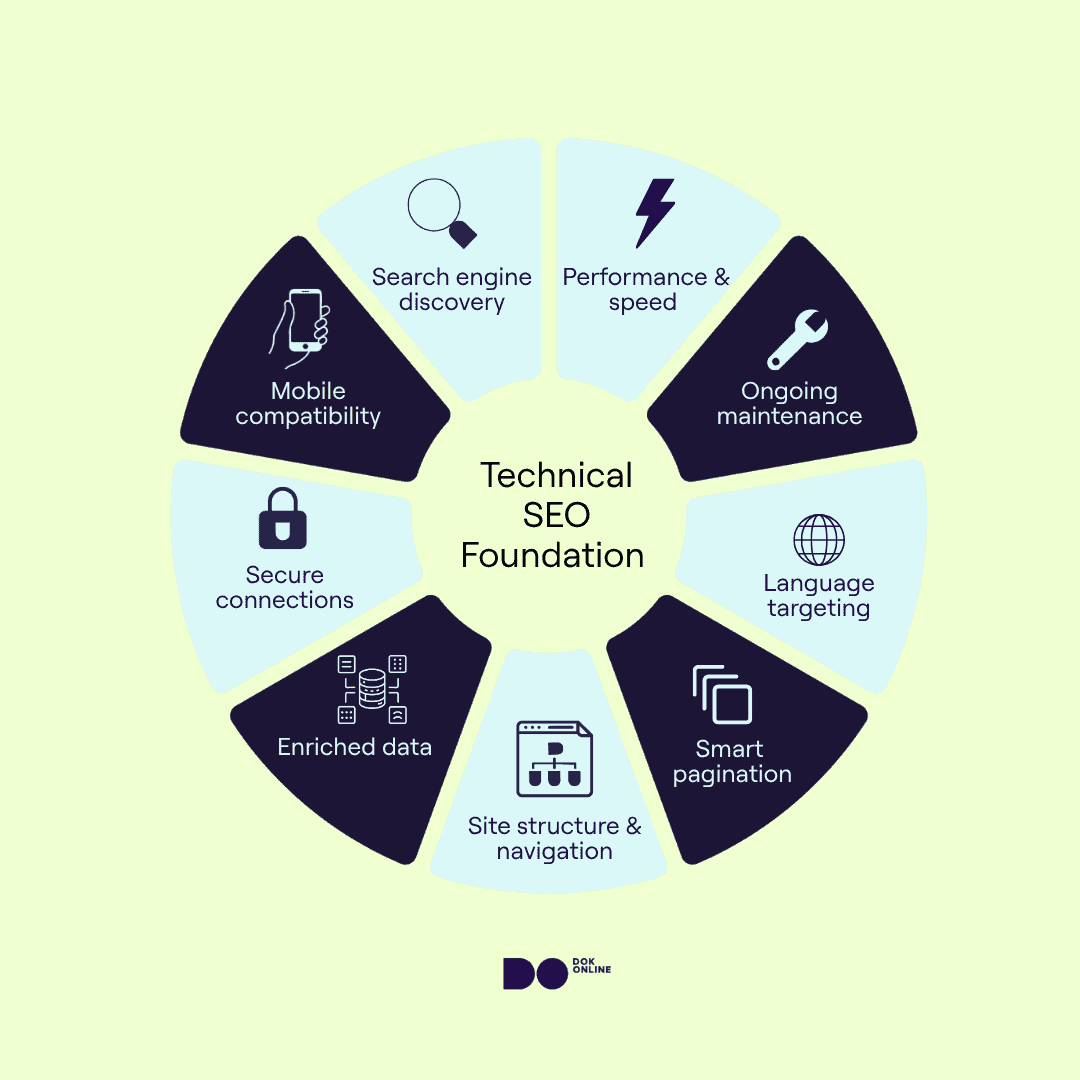
- Indexing & crawling
- Mobile-friendliness
- Site speed & performance
- HTTPS implementation
- Site architecture & navigation
- Structured data
- Pagination & faceted navigation
- Multilingual SEO
- Technical hygiene & audit
These are the 9 core areas that form the basis of every technical SEO strategy, regardless of whether you’re working with a small business site or a complex e-commerce platform. Let’s have a look at each of them in detail.
1. Indexing & crawling
Search engines can only rank what they see. That’s why technical SEO begins with controlling how bots navigate your site, which pages should be included in the index, and where crawl priority should lie.When search engines waste time on low-value or blocked pages, your most important content may be missed or delayed.
Four key mechanisms influence how indexing and crawling work across your site. By understanding these, you cut through the clutter and show search engines which pages you want it to consider and which to ignore.
XML sitemap
An XML sitemap acts as a blueprint for search engines. It lists the URLs you want indexed and signals which content matters most.
However, simply generating a sitemap isn’t enough. It should only include live, indexable pages. Outdated URLs, 404s, redirects, or pages set to noindex dilute the quality of your sitemap and mislead Google’s crawl logic.
Before submitting a sitemap, always validate it through tools like Google Search Console. You can also ensure it is dynamically updated if the inventory changes frequently in your store.
We once audited a webshop whose sitemap included over 2,000 URLs – but nearly 800 of those pointed to soft 404s, redirects, or deindexed pages. The result? Important product and category pages were being ignored, and crawl efficiency suffered. Upon our recommendation, sitemap was fixed and resubmitted. Within three weeks, the traffic to the site improved by 30%.
Robots.txt files
The robots.txt file tells search engines what not to crawl, but it doesn’t stop those pages from being indexed if other signals exist (like backlinks). In other words, it controls crawl behaviour, not indexing status.
You should use robots.txt to block access to low-value or repetitive paths — like e-commerce filter parameters or admin folders — but never block resources like JavaScript or CSS if they’re critical for rendering.
On a large retail site, it’s often a good idea to block pages like /wishlist/, /compare/, /search/ or filter links like /jeans?sorter=low-to-high/.
These are useful for users but have no SEO value and don’t need to be crawled. After all, if Google wastes time crawling internal tools, filters, or duplicate product listings, it spends less time on the pages that actually matter like your bestsellers or landing pages. That can delay indexing and slow down your performance in search.
What you shouldn’t block are folders that contain important files — like JavaScript or CSS that control how your site looks and functions. If Google can’t access these, it may assume your page is broken, especially on mobile.
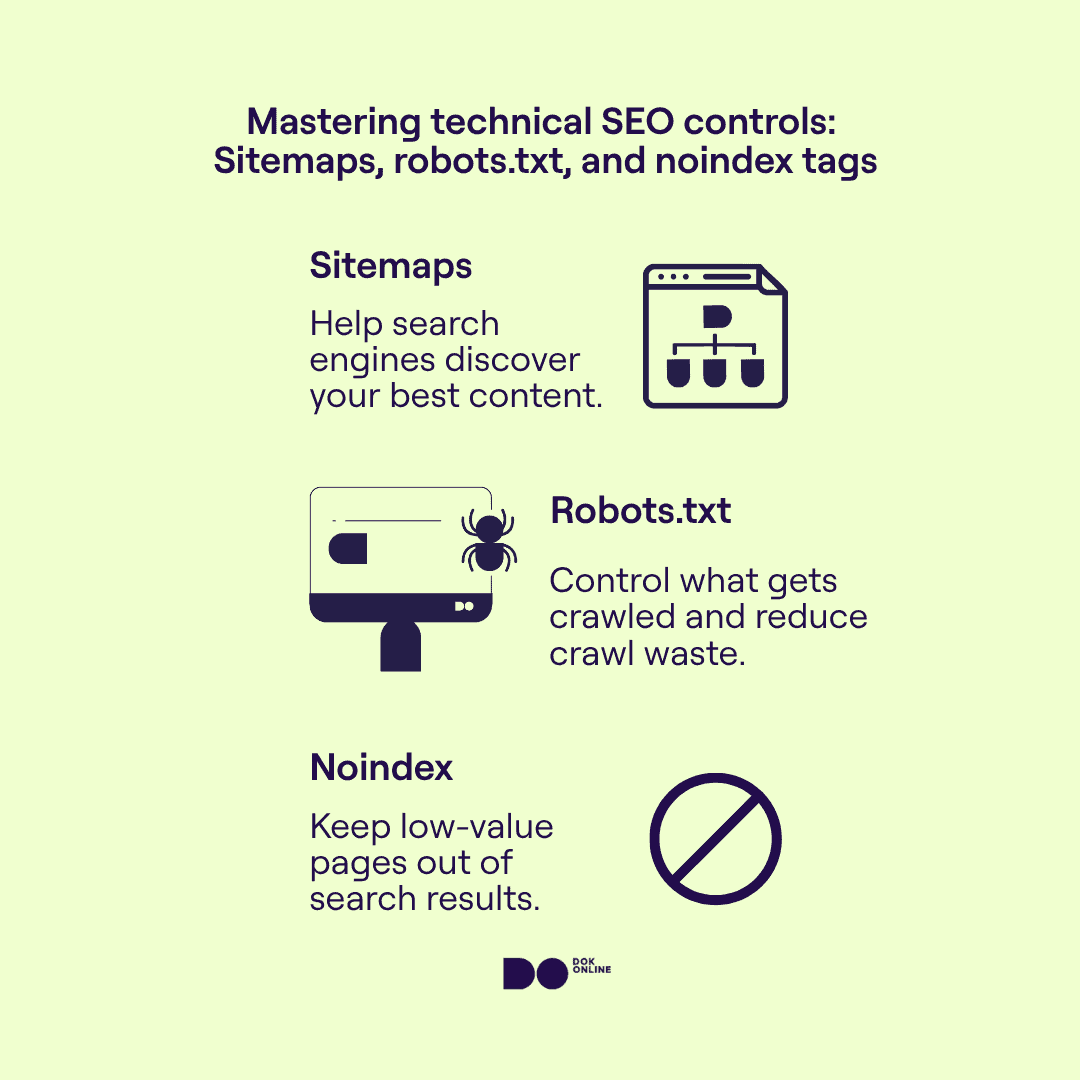
Noindex directives
The noindex tag tells search engines not to include a page in the index — even if it’s crawlable. It’s especially useful for thin, duplicate, or utility pages that you don’t want appearing in search results.
For example, a booking platform might have thank-you pages like /thank-you/booking-confirmed or utility pages like /terms-and-conditions that are necessary for users but not helpful in search results. If these pages get indexed, they clutter your presence and may even outrank pages that matter more.
In this case, adding a noindex tag keeps the page functional and crawlable but tells Google not to include it in search. It’s a simple way to protect your rankings while keeping your site experience intact.
The noindex tag should be placed in the <head> section of the HTML using a meta robots directive, like <meta name=”robots” content=”noindex”>.
Just don’t confuse it with robots.txt. Where robots.txt stops crawling, noindex stops indexing — and you can use both together strategically, depending on the page type.
Canonicals
Canonical tags are used to point search engines to the preferred version of a page when multiple versions exist with similar or duplicate content. They’re an essential tool for keeping your site’s index clean — especially when dealing with parameters, tracking codes, or product variations.
Example use cases include:
- Filtered URLs like /products/t-shirt?color=blue
- Pages with tracking parameters: /products/t-shirt?utm_source=newsletter
- Identical product listings under different categories
For example, imagine an online furniture store selling the same chair under both the ‘Office’ and ‘Living Room’ categories. Both URLs load the same product, just from different menu paths:
- /office/chair-x
- /living-room/chair-x
Without a canonical tag pointing to the main version (for example, /office/chair-x), search engines may treat these as two separate pages, splitting ranking signals and possibly indexing both. Canonicals consolidate those signals so the right version shows up in search.
The decision to choose the main page comes down to engagement metrics like traffic and conversions.
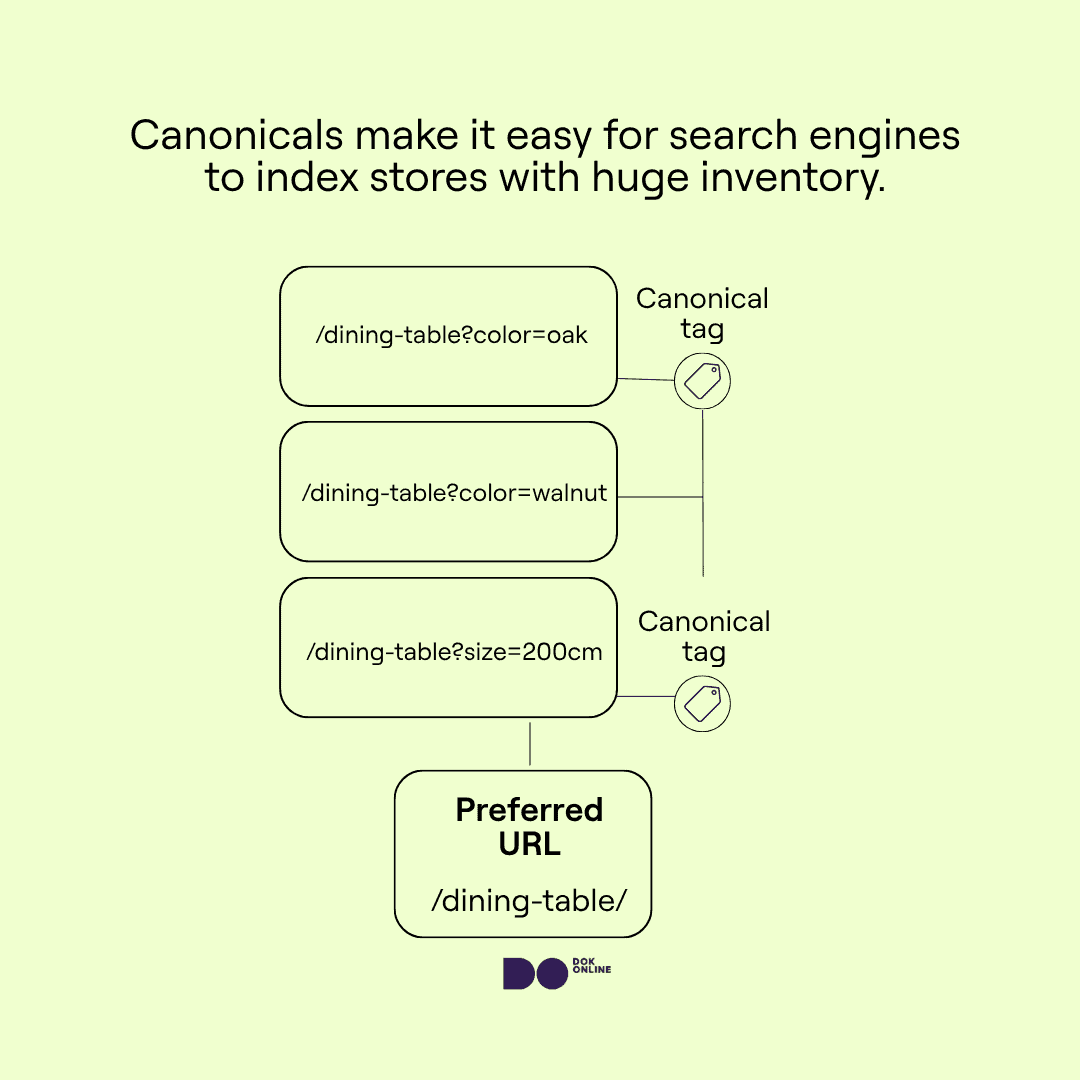
2. Mobile optimization and mobile-first indexing
Google now primarily uses the mobile version of your site to determine how it ranks in search results. This shift, known as mobile-first indexing, means that your mobile performance isn’t optional — it’s the benchmark.
You may be selling the best products on the market at most competitive prices – or your blog may be the leading expert in the industry. However, if people use your site on their mobile phones, none of it matters.
With over 60% of searches happening on mobile devices, this isn’t just about satisfying Google. It’s about serving users where they are — and ensuring your mobile site is just as fast, readable, and functional as the desktop version.
From an implementation standpoint, there are different ways to handle mobile SEO:
- Responsive design: A single site that adjusts to screen sizes. This is the safest and most SEO-friendly setup.
- Adaptive/dynamic serving: Different content delivered depending on the device. These setups require extra care to avoid content mismatches and crawl errors.
We recommend responsive design in nearly every case — it’s easier to maintain, avoids duplication issues, and ensures all users and bots see the same content.
But design alone isn’t enough. Even well-coded mobile sites can underperform if key website technicalities are ignored:
- Keep font sizes to a minimum of 16px on small screens.
- Buttons placed too closely together can trigger the wrong actions.
- Horizontal scrolling frustrates users and disrupts layout rendering.
- Full-screen popups that appear on entry (especially on mobile) can block content and lead to ranking penalties under Google’s intrusive interstitials guidelines.
At Dok Online, we often see websites with solid desktop scores struggle on mobile due to layout shifts and slow responsiveness caused by bloated themes or uncompressed assets. One example is Amerika Nu, a content-heavy site that was underperforming on mobile due to bloated themes and uncompressed images. By auditing the site’s asset delivery and trimming unnecessary third-party scripts, we helped reduce mobile load time from 4.3s to under 2s. The result: a 28% lift in organic traffic over the next quarter – without changing a single content page.
These problems aren’t just bad UX – they also feed directly into Core Web Vitals performance scores, which we look at next.
3. Site speed & performance
Site speed directly impacts user experience, SEO performance, and conversion rates. Slow-loading pages frustrate users — and those users leave. Google picks up on those behavioral signals, making speed a ranking factor not just through Core Web Vitals, but also through increased bounce rates and lower engagement.
In today’s ranking systems, user experience carries more weight than ever, especially under the Experience element in Google’s E-E-A-T framework. If your site loads slowly, it’s not just a technical failure but also a trust and quality issue.
This isn’t just a developer issue. It’s a problem for business growth and user experience. We’ve worked with businesses where shaving even one second off mobile load time led to measurable gains in form submissions, product views, and ranking stability.
The most impactful performance improvements often come from a few focused changes:
- Compressing and properly sizing images
- Leveraging browser caching
- Reducing unused CSS and JavaScript
- Lazy-loading below-the-fold assets
Hosting and infrastructure matter too. A fast server, a properly configured content delivery network (CDN), and a well-coded, lightweight theme all help keep your site loading quickly. If your theme includes lots of animations, bloated code, or loads unnecessary fonts and scripts, it may be slowing you down — even if it looks great.
This is especially important on platforms like WordPress or Shopify, where performance is often affected by third-party plugins. Tools like Lighthouse or GTmetrix can help you spot whether your theme is dragging down your performance.
Core web vitals
Core Web Vitals are a set of user-focused metrics that measure how quickly your page loads, becomes interactive, and remains stable as it loads. Google uses these metrics to assess the real-world experience of your website, especially on mobile devices.
There are three primary metrics to watch:
- Largest Contentful Paint (LCP): How quickly the main content appears.
Target: under 2.5 seconds - First Input Delay (FID): How fast the page reacts when a user interacts.
Target: under 100ms - Cumulative Layout Shift (CLS): How much the layout shifts while loading.
Target: below 0.1
Poor scores in any of these can lead to lower rankings, especially in competitive sectors. And while they may sound technical, many of the fixes are straightforward. For instance, ensuring fonts are preloaded, setting image dimensions, or removing layout-shifting banners.
At Dok Online, we often use tools like Google Search Console, PageSpeed Insights, and Lighthouse to identify where pages fall short.
For one of our clients, a SaaS landing page was underperforming due to a slow LCP caused by a large hero image and background video. Once optimized, the page moved from a ‘poor’ to ‘good’ performance score and its keyword position jumped three spots up within two weeks.
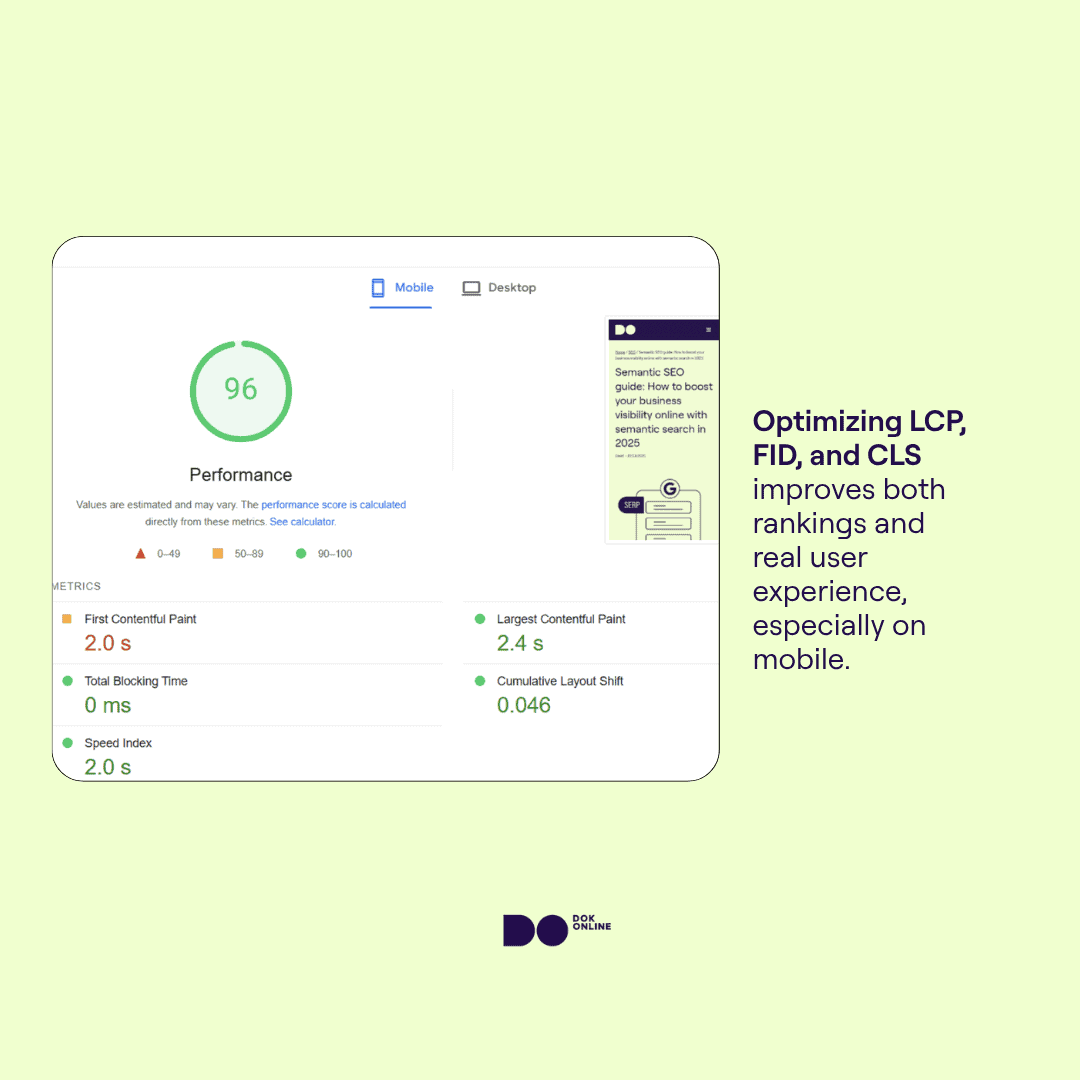
4. HTTPS security
HTTPS is no longer optional but a baseline requirement for SEO, security, and user trust.
Imagine reaching a checkout page and being greeted by a broken lock icon. With this, there is a browser warning that your connection isn’t secure and your data could be at risk.
Would you still buy from that site? No? Neither would your own target audience so make sure to use the secure HTTPS:// protocol instead of HTTP://.
Google confirms that secure sites receive a ranking boost, and modern browsers now actively warn users when they visit an insecure (HTTP) page. For businesses in ecommerce, SaaS, or lead generation, that warning alone is enough to kill a conversion.
How do you implement the secure protocol? By installing an SSL certificate on your domain. But it’s not just about encryption. It is about making sure your entire site runs securely, with no gaps.
Here’s what a best practice for a secure protocol looks like:
- Install a valid SSL certificate and ensure it’s renewed automatically.
- Redirect all HTTP pages to HTTPS using permanent (301) redirects.
- Avoid mixed content issues. This happens when secure pages load assets (like images, scripts, or fonts) from HTTP sources, triggering browser warnings and blocking those resources.
We often see this last point overlooked during partial migrations.
For example, a client in the home improvement space had correctly installed SSL and redirected URLs, but embedded videos and product images were still being loaded over HTTP. Not only did this break visual elements on mobile, it also slowed the page speed and triggered browser-level warnings, which undermined both SEO, and trust.
5. Site architecture & navigation
Site architecture refers to how pages are organized, linked, and prioritized within your website. It’s the hierarchy and organization of information across your site.
Take an online store that sells furniture. The main navigation might include categories like Living Room, Bedroom, and Office. Under ‘Living Room,’ you’d find subcategories like Sofas, Coffee Tables, and TV-Stands.
Each product page, like a gray L-shaped sofa, is placed within the right subcategory and linked back to related collections such as ‘Best Sellers’ or ‘Modular Seating.’ This type of structure keeps things organized, helps customers browse with ease, and signals to search engines which pages carry the most weight.
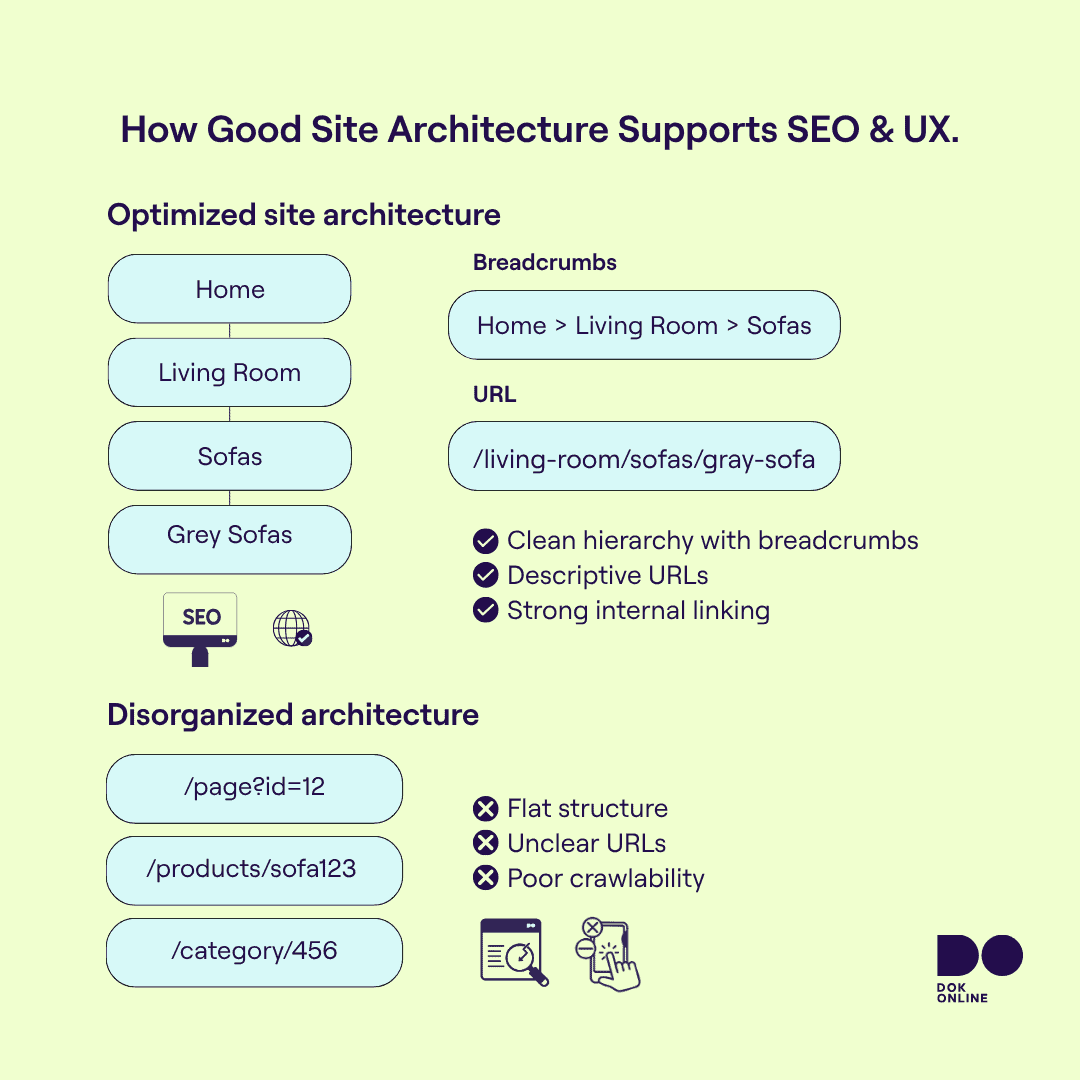
Good architecture practices combine UX and SEO: When your navigation mirrors how users think, you get a structure that benefits both people and search engines. Three core elements help drive this:
Breadcrumb paths
Breadcrumbs are navigational links that show users the path from the homepage to the current page. They typically appear near the top of a page and reflect the structure of your site — like Home > Women > Dresses > Summer Collection.
When users land deep within your site; whether on a product page, blog post, or filtered category; breadcrumbs help them understand where they are and how to navigate upward. They provide a clear trail back to broader sections, and for search engines, they reinforce how your content is nested and related.
They serve two important purposes:
- Improve UX by making it easier for users to backtrack or explore related sections
- Enhance SEO by clarifying page hierarchy and enabling rich snippet enhancements when marked up with schema (BreadcrumbList)
On larger category-based sites, like ecommerce platforms or travel providers, breadcrumbs reduce friction and encourage exploration, especially on mobile.
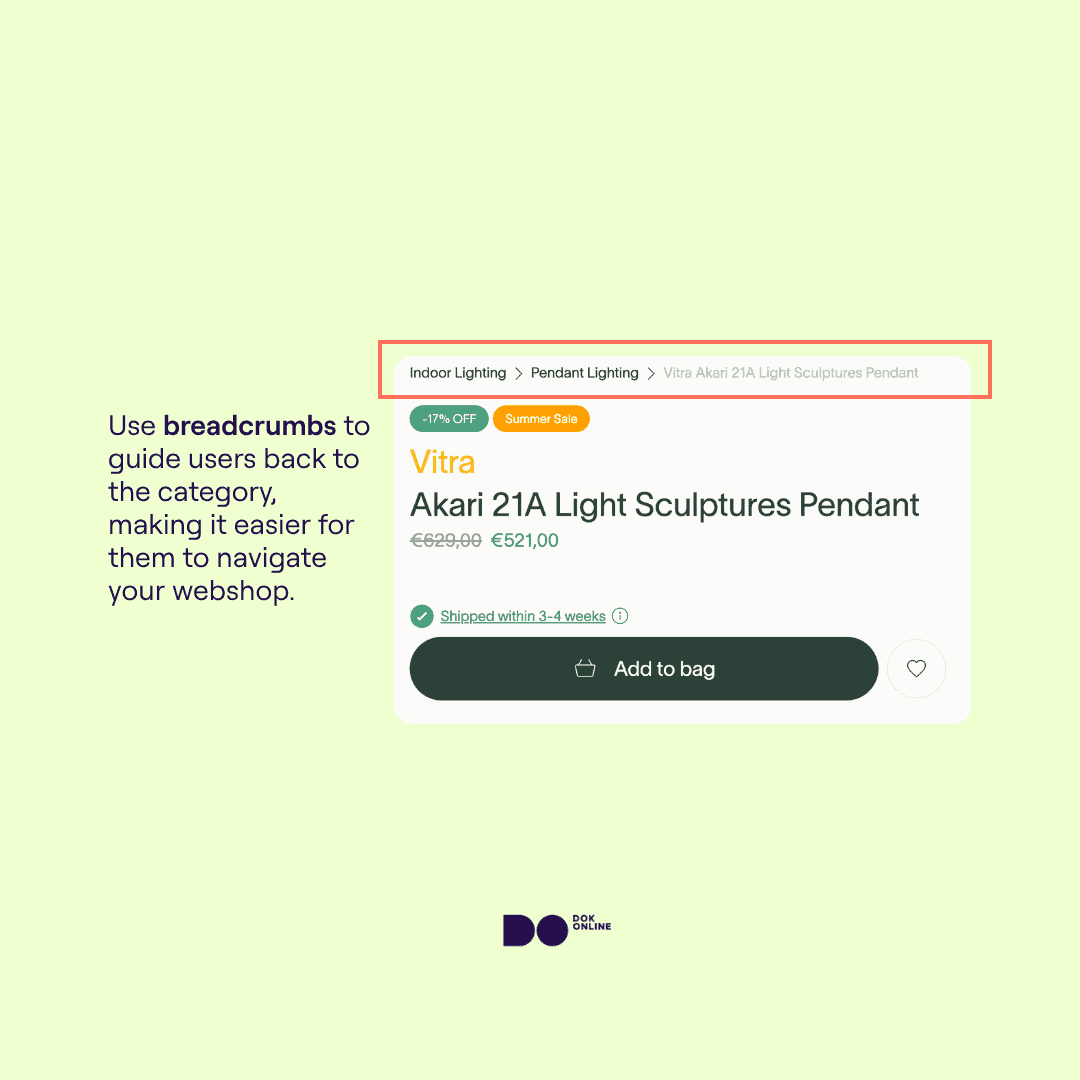
URL structure
Your URL structure is one of the first signals search engines and users see. It often determines whether a page appears clean, professional, and worth clicking. Beyond aesthetics, URLs help Google understand page content and topic relevance, especially when keywords are included in the URLs naturally.
At Dok Online, we follow a comprehensive set of URL rules. Here’s the gist of our URL rules::
- Use lowercase, hyphen-separated URLs (e.g. /mens-shirts/)
- Avoid long query strings or technical parameters (e.g. ?id=8239&ref=abc)
- Make URLs descriptive and keyword-relevant rather than uninformative (e.g. /productivity-software/ vs. /page-2)
- Do not use filler words like prepositions and conjunctions.
- Use nested URLs with folders & subfolders.
On dynamic websites, URL variants can quickly spiral — especially with filters, session IDs, or tracking tags. Without proper canonicalization and parameter handling, this can lead to index bloat and diluted authority.
Internal links
Internal linking is one of the most overlooked parts of technical SEO — yet it’s one of the most powerful tools for guiding search engine crawlers and distributing authority across your site. It acts as your site’s internal roadmap, telling Google which pages are important, how they relate to one another, and what topics you specialize in.
From an SEO perspective, the best internal linking practices focus on the following:
- Anchor text should be clear and descriptive, ideally using the target keyword or topic.
- Link strategically — don’t overload a page with dozens of links or repeatedly link the same page in the same context.
- Interlink contextually. The link should be placed in a section that is contextually close and relevant to the page you are internally linking to.
- Make sure every important page is reachable through at least one internal link — orphaned pages often go unindexed.
Find out what’s holding your site back
Want to know if crawl issues, slow loading, or messy structure are limiting your rankings? Book a call to find out what needs fixing, what to prioritise, and how to move forward.
6. Structured data and schema markup
In plain terms, structured data is a way to label your content so that search engines can understand what it means. Marking up a web page means making it machine-readable.
For example: marking up a product page lets Google know that a certain set of numbers is the price; which currency the price is in and that another set of numbers is the amount of items left in stock; etc. Those elements can then be interpreted in the correct way and show up directly in the search result.
In fact, you can even provide additional information on your product like weight, size, shipping, and return policy in a way that Google and other tools understand the implications of it.
Structured data helps you speak the language of Google and make your content stand out. It gives you a better shot at featured snippets, rich results, and enhanced visibility in search listings. In other words, the more you help search bots understand your page, the easier it will be for them to display it in the results. Common schema types include Product, FAQ, Article, and LocalBusiness — helping your pages qualify for rich results and better search visibility.
In the example below, we see that the ‘Matcha’ category page has six different schema types – including Articles, FAQs, and breadcrumbs – as checked in the Rich Results Validator. Clearly, that has contributed well for the page to rank #1 for a broad KW like ‘organic tea.’
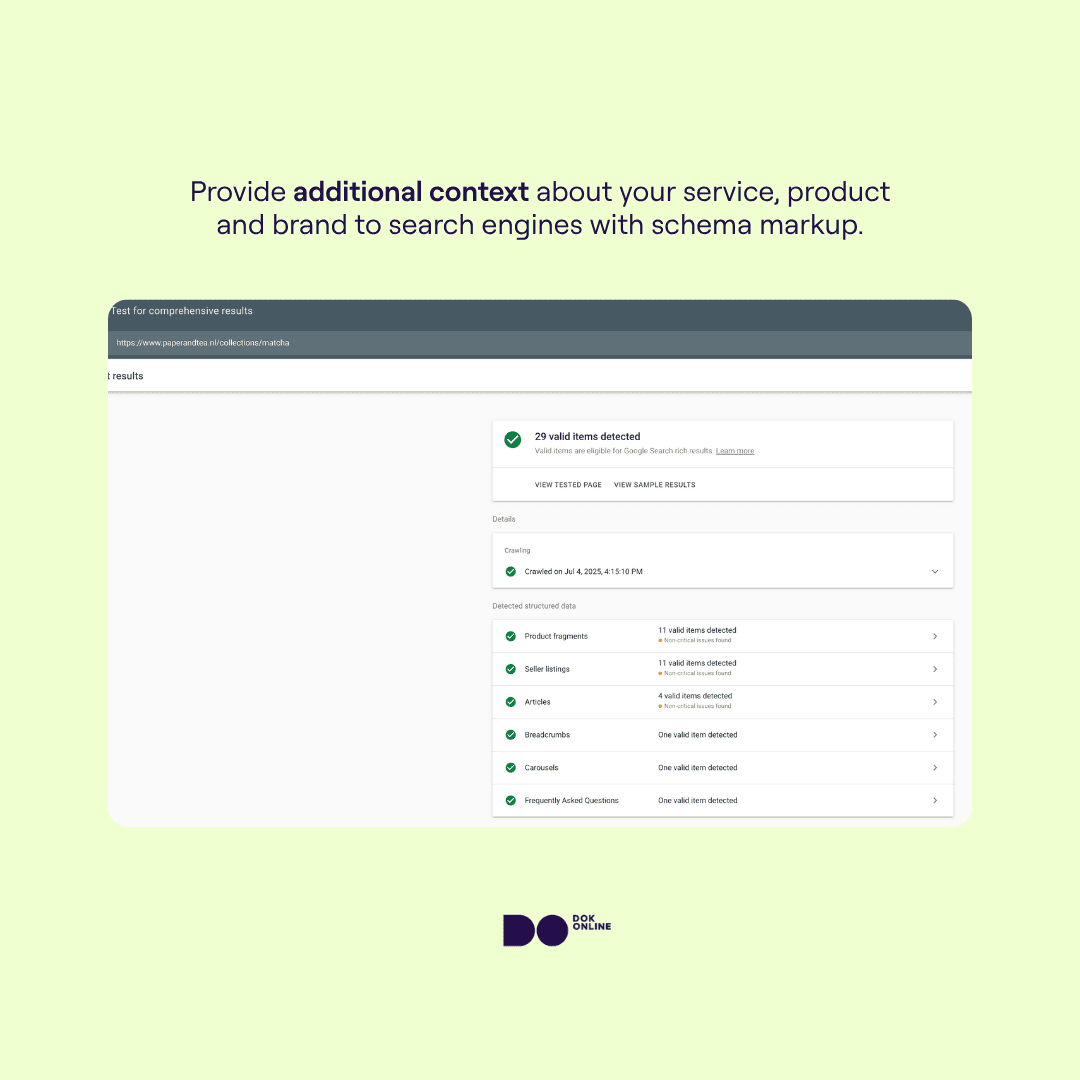
7. Pagination & faceted navigation
Pagination and faceted navigation help users explore content more easily while browsing through product or blog pages, or narrowing down a category with specific attributes. But from a technical SEO perspective, these same features can quickly become crawl traps, create duplicate content, and bloat the index if left unchecked.
Let’s take a look.
- Pagination refers to splitting content across multiple pages; like a blog archive with ‘Page 1, 2, 3,’ and so on.
- Faceted navigation is the filtering system often used in ecommerce, where users can select size, color, brand, or other attributes to narrow down product results.
While these improve UX, they also generate multiple URL variations that differ only slightly. For example, consider the following:
/shoes?color=black&size=42
/shoes?brand=nike&sort=price_asc
These filtered URLs can:
- Waste crawl budget on low-value combinations
- Cause duplicate content issues when multiple filtered URLs show near-identical content
- Lead to thin pages being indexed that weren’t meant to appear in search at all
The goal isn’t to remove pagination or filters. It’s to configure them in a way that supports both – user experience and SEO performance.
Here’s how to do that effectively:
- Use standard links for paginated pages, such as ‘Next’ or page numbers. Avoid buttons that only work with scripts or clicks, because search engines often skip those.
- Add canonical tags to filtered pages to tell Google which version of the page should be treated as the main one. This prevents duplication and confusion.
- Use noindex on pages that offer little value, such as empty filters or internal search results, so they do not appear in Google.
- Make sure important content loads without JavaScript. If key navigation or text only appears through scripts, Google may miss it during indexing.
You might still see references to rel=’next’ and rel=’prev’ for paginated content, but Google no longer uses them. What still matters is having a clear, logical pagination structure that search engines can crawl easily.
8. Multilingual SEO
If your business serves customers in more than one country or language, you already know how tricky it can be to get the right content in front of the right people. You’ve translated your pages, set up local versions… and yet, your English site ranks in the Netherlands while your Dutch content is nowhere to be seen. Sound familiar?
This is where multilingual or international SEO comes in. It’s about making sure Google knows which version of your site to show to which audience. And the truth is, most websites get this wrong.
The most common issue? Missing or incorrect hreflang tags. These are small bits of code that tell Google things like: ‘This page is for Dutch speakers,’ or ‘This version is meant for Germany.’ Without them, search engines are left guessing and they often pick the wrong version.
For example, if you set up hreflang incorrectly — like pairing Dutch (nl) with Germany (de) — Google may assume your Dutch page is intended for a German audience. Since Dutch isn’t a primary language in Germany, this mismatch can hurt visibility in both regions, even if your content is strong.
To avoid these issues on your site, here’s what we recommend:
- Use clear language-specific subfolders, such as /nl/ or /en/.
- Add hreflang tags that point both ways and self- referencing. Every language version acknowledges the others.
- Set up logical hreflang combinations (e.g. nl-de would not be logical as Dutch is not a primary language in Germany.
- Keep hreflang consistent across all methods (HTML, headers, sitemaps)
Double-check that each language version is properly set up and not just translated
Search engines don’t punish sites for offering multiple language versions. But they do penalize confusion. Getting hreflang right ensures the correct audience sees the right version of your site.
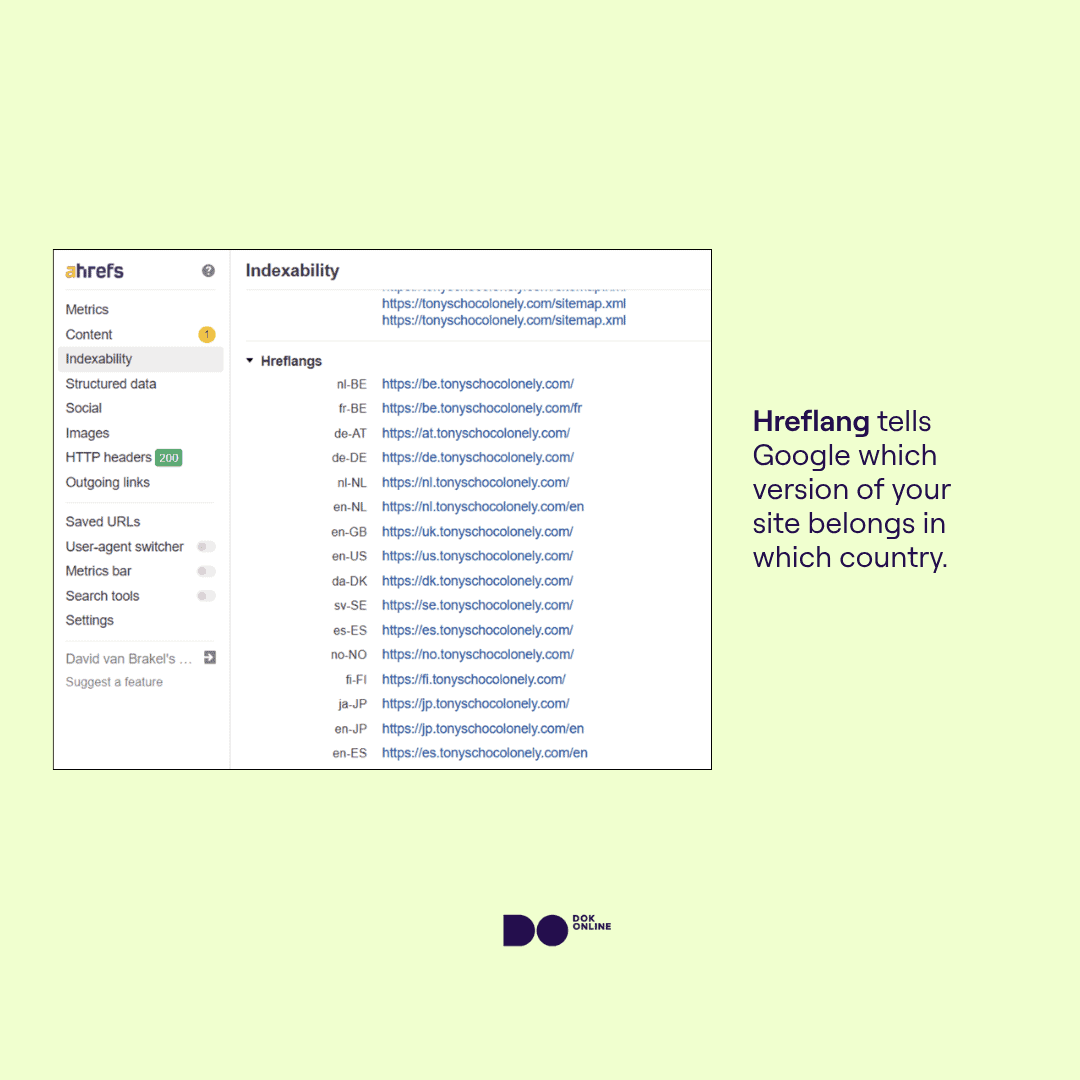
In this example from our client Tony’s Chocolonely, a multinational chocolate brand operating in over 10 countries, we can see a well-implemented hreflang setup across multiple regions and languages for their main page tonyschocolonely.com.
Each version of the site — from Dutch in Belgium (nl-BE) to English in the US (en-US) — has its own dedicated URL. This tells Google which page to show in each language market and helps avoid duplicate content issues across regional domains.
9. Regular technical hygiene & audits
Even if your site was perfectly set up six months ago, that doesn’t mean it’s still performing the way it should. Redirects pile up, pages get removed, tags break, and new features often introduce issues no one notices until rankings drop. Just like any part of SEO, technical SEO is not a one-time thing, it’s an on-going task.
Regular technical audits help catch issues early, before they cause traffic- or conversion-loss.
Dok Online can help you with technical audits. Whether you want us to set the record straight and get your site technically back on track, or get you started with a regular maintenance routine. What we look for during a technical audit, is:
- Broken links, both internal and external
- Redirect chains or loops that slow down crawling
- Orphaned pages that are not linked anywhere on the site
- Index bloat, where low-value pages are being indexed unnecessarily
- Staging or test URLs showing up in Google results
- Performance issues, like large images or excessive third-party scripts
On top of that, your site may pose specific challenges, based on which CMS or tech stack set-up you use.
At Dok Online, we recommend a full technical audit at least once a quarter. For larger sites or high-growth businesses, weekly reviews can help keep your infrastructure clean and scalable. The goal is not just to fix what’s broken. It’s to create a site that stays fast, efficient, and fully visible as it evolves.
What are the common technical SEO mistakes?
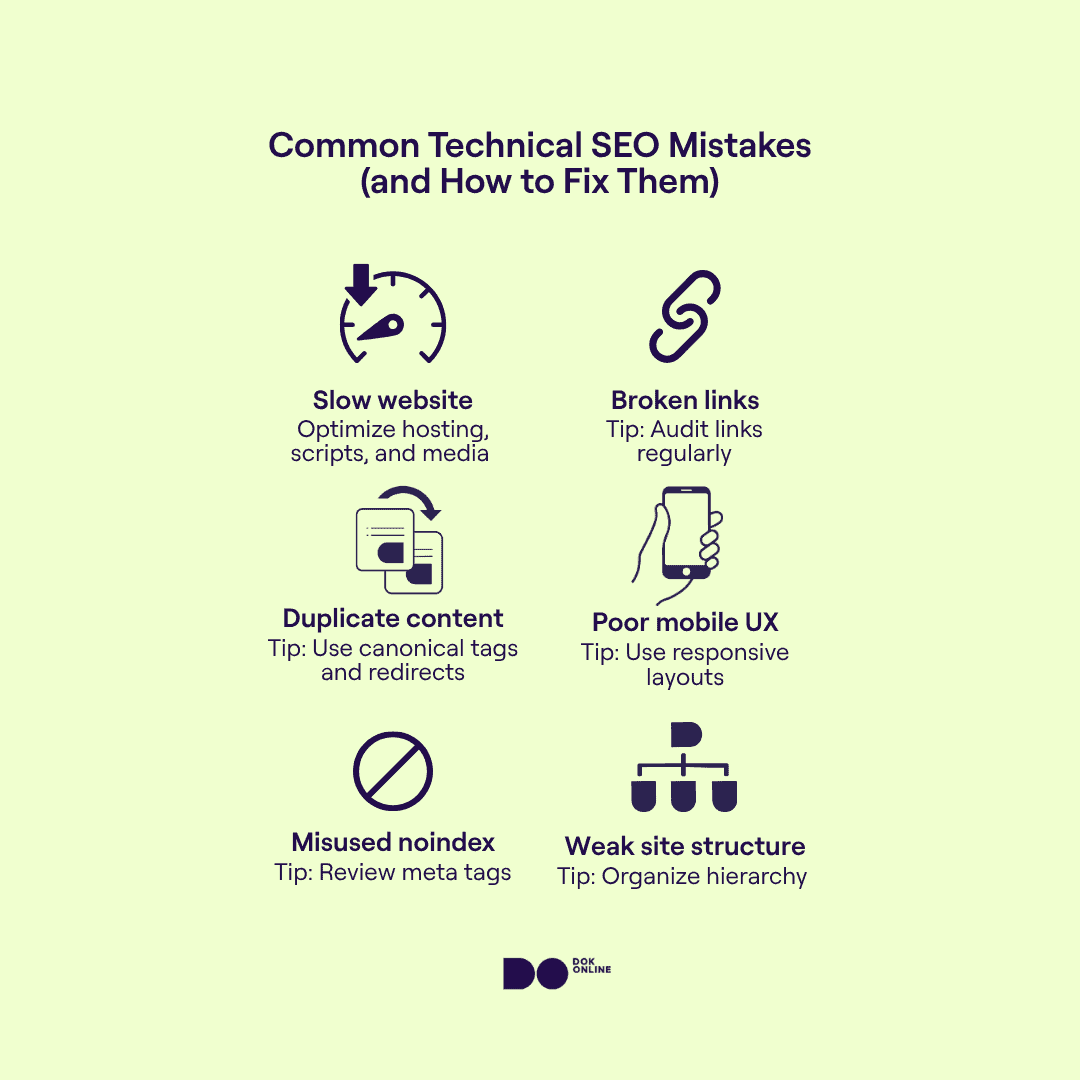
- Slow website speed
- Broken internal links
- Unoptimized content
- Poor mobile rendering
- Wrong hreflang
- Misused noindex or canonicals
- Poor site structure
Keep this section unique from the previous sections.
Most technical SEO mistakes don’t announce themselves. There’s no error message or broken layout. They sit quietly in the background and hold your site back, gradually dragging your revenue and traffic down. These issues are usually not caused by bad strategy. They come from small oversights, broken technical bits, or outdated settings that build up over time.
Here are some of the most common issues and how to fix them:
- Slow website speed: This is often due to uncompressed images, outdated plugins, or bloated page builders. These slow down load times and frustrate users. Compressing images, streamlining assets, and removing unnecessary scripts can significantly improve performance.
- Broken internal links: Broken links confuse both users and search engines. They disrupt navigation and weaken your internal linking strategy. Regularly auditing your site helps identify and fix these.
- Duplicate content: This can happen because of CMS quirks, filtered URLs, or pagination. These variations often show the same content under different URLs. You can fix this with canonical tags and redirect rules that point to the correct version.
- Poor mobile rendering: Content that works on desktop may be hidden, cut off, or difficult to use on mobile devices. This affects user experience and search visibility. Responsive layouts and mobile testing can catch these issues early.
- Misused noindex or canonical tags: If placed incorrectly, these tags can remove important pages from search results or send signals to the wrong page version. They often sit unnoticed in templates. A regular technical audit helps uncover these problems.
What technical SEO looks like across different business models?
Technical SEO is not one-size-fits-all. A site with 300 blog posts does not have the same problems as one with 10,000 products. The tools might be similar, but the focus, priorities, and risks are completely different. We tailor every audit and technical strategy to fit what the site is built to do, not just what platform it runs on.
The business model shapes the SEO challenges. Here’s how we adapt our approach across three common site types.
Technical SEO for Ecommerce websites
Ecommerce sites often run on platforms like Shopify, Magento, or WooCommerce. These sites deal with scale and complexity thousands of product URLs, filter systems, and content that changes with stock or season.
Common challenges within e-commerce SEO include:
- Crawl traps from filter combinations such as /shirts?size=m&color=blue
- Duplicate content across product variants and colour or size pages
- Schema markup gaps for key product types like Product, Offer, and Review
- Slower load times due to image-heavy pages and theme bloat
- Conflicts between canonical tags on category and product URLs
For ecommerce clients, we help:
- Prioritize crawlable and indexable pages, avoiding wasted crawl budget
- Tighten canonical structure across products and collections
- Automate structured data at scale across product templates
This keeps the site lean, discoverable, and easier to scale as inventory grows.
Technical SEO for SaaS & B2B sites
SaaS and B2B websites are typically smaller in size but higher in intent. These sites don’t have thousands of pages, but every page plays a specific role. This can be anything from lead generation to product education.
Common issues include:
- JavaScript-heavy landing pages that slow down or fail to render correctly
- Key content hidden or delayed, such as pricing or FAQs
- Weak Core Web Vitals on feature or demo pages built with visual builders
- Poor internal linking between help docs, blog posts, and conversion pages
Our focus here is on:
- Improving crawlability without bloating the index
- Optimising performance on key lead-gen pages
- Structuring internal links so Google understands product and support relationships
- Adding structured data like FAQs, How-tos, and Knowledge Panels for visibility
This helps drive qualified traffic to the right part of the funnel and keeps the site technically solid as it evolves.
Technical SEO for content publishers & blogs
Content-heavy websites — like publishers, education platforms, or large blogs — face a different kind of challenge. They rely heavily on clean indexation, scalable structure, and crawl control.
Common issues we solve include:
- Orphaned articles that are published but never linked internally
- Inefficient pagination systems that scatter crawl paths
- Duplicate or missing meta data and inconsistent heading structures
- Site speed problems from outdated plugins or media-heavy layouts
To support these sites, we:
- Audit and restructure crawl paths to improve discoverability
- Build topic clusters and internal linking frameworks
- Clean up old categories, unused tags, and broken archive structures
For sites with hundreds or thousands of pieces of content, this kind of technical clarity is essential for both user experience and long-term organic performance.
How technical SEO compares to on-page & off-page SEO?
SEO is often talked about as one big concept, but in reality, it breaks down into three core areas: technical, on-page, and off-page. Understanding the difference between them helps you identify where your current gaps are — and what needs the most attention.
- Technical SEO is the foundation. It ensures your site can be crawled, indexed, loaded quickly, and understood by search engines. Without it, the rest of your efforts may never be seen.
- On-page SEO is about content quality and relevance. This includes your keywords, headings, internal links, and how well a page satisfies search intent.
- Off-page SEO builds authority. It includes backlinks, brand mentions, and other external signals that tell Google your site is trustworthy and important.
Each of these pillars supports the others. Strong content cannot rank without crawl access. Great links won’t help a site that loads slowly or blocks Googlebot. And technical strength alone won’t move the needle without strategic content and authority behind it.
At Dok Online, we work across all three pillars — but we often start by fixing the technical foundation. If that base is weak, you’ll never get the full value from your content or link-building.
| Attribute | On-page | Off-page | Technical |
| Main focus | Authority, trust, reputation | Content quality, keywords, UX | Crawlability, speed, structure |
| What is done? | Link building, PR, outreach | Content optimisation, meta tags | Fixes to code, tags, sitemap, robots.txt |
| What tools are used? | Ahrefs, Majestic, BuzzSumo | Surfer, Yoast, Clearscope | GSC, Screaming Frog, PageSpeed Insights |
| Main goals | Authority and ranking power | Relevance and clarity | Indexing and site health |
| Who takes ownership | SEO strategists and outreach teams | SEOs and content teams | Developers and technical SEOs |
| What happens without it? | Site lacks trust and visibility | Content won’t match user intent | Site may not be visible or crawlable |
Get your technical SEO advantage: How Dok Online builds for the search machines
Dok Online can help you make sure your site works as intended. For users AND search engines. Whether you want to build a new one, fix an existing one or migrate to another system.
We handle seamless site migrations and in-depth technical audits — preserving rankings, fixing crawl issues, and unlocking growth by addressing index bloat, broken links, redirect gaps, and speed problems.
Reach out plan a meeting to discuss how we can help your business to stay on top of its game through a website that excels in every way!